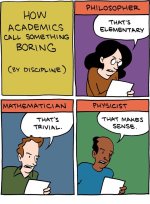bilby
Fair dinkum thinkum
- Joined
- Mar 6, 2007
- Messages
- 40,289
- Gender
- He/Him
- Basic Beliefs
- Strong Atheist
But saying it's "the observational apparatus itself that causes wave function collapse" isn't changing the effect or having it act a bit differently from its real world behavior. It matches the observed real world behavior to a T. That's why the infamous "it takes consciousness to collapse wave functions" interpretation of quantum mechanics is an interpretation, not a case of playing fast and loose with the science for the sake of the story, or for the sake of love of mysticism. A lot of hard-nosed first rate physicists have accepted that interpretation, most famously Eugene Wigner, who won a Nobel Prize. The consciousness interpretation is named after John von friggin' Neumann, although it's not clear whether he actually favored it or merely considered it an equally viable possibility. The physicists who accept that view do not do so because they're under the spell of new age woo peddlers. They do so because they feel pushed into it, much against their natural inclinations, by all the severe difficulties with all the alternative interpretations.Sorry for the delay in responding - I was in the process of reading it when you PMed me, and I have deliberately been avoiding reading this thread until I finished in case of spoilers.
As I see it, Liu was employing the observer effect as a plot device - a way for the researchers to realize that they were being spied upon. When Ball Lightning is considered as a kind of prequel to Three Body, this makes a lot of sense from the narrative perspective. My first thought was that in such a 'noisy' environment, an uncollapsed waveform would be hugely implausible - but then, so is an electron the size of a soccer ball, or atomic nucleii that fuse at low temperatures and emit energy that effects very specific materials while leaving others unaffected. In short, it's science fiction, and the laws of physics can be whatever the author wants them to be. Liu has an excellent core of hard science in his work, but it necessarily takes a back seat to telling the story he wants to tell.
When a major thread of your novel is the exploration of quantum weirdness at macroscopic scales, it would be difficult and surprising to waste something as strange as the observer effect, by not having it too act rather differently and on a rather larger scale from its real world behaviour. I think it's excusable in this case, just as are the changes he makes to the other effects he appropriates. He isn't writing a textbook; He's speculating about how things would be if things were just a bit different. All SciFi does that - and IMO he does it better than most.
Of course it's shocking that something so prima facie ridiculous could come from serious science. But anybody who thinks that's all it takes to settle the matter should heed Niels Bohr's dictum: anybody who isn't shocked by quantum mechanics has not understood it. Not saying the consciousness hypothesis is right -- what do I know? Just saying people who treat the idea with the contempt it's getting in this thread are de facto claiming Wigner and von Neumann were idiots. They weren't idiots. They were smarter than all of us put together.
Liu goes somewhat outside the lines though. But only slightly. And for sound narrative reasons.
In some parts of the book, superposition takes considerable time to 'fade' after an observer is introduced. It works within the story, and he's not trying to write a textbook. IMO it's excellent science fiction, and doesn't stray far from reality (to the best of my ability to tell - I suspect he knows a lot more than I do on the subject). I am not aware of any observations of gradual wave function collapse. But then, there are lots of real things that I am not aware of.

